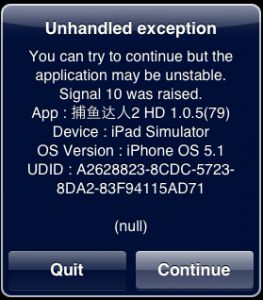如何让IOS应用从容地崩溃
虽然大家都不愿意看到程序崩溃,但可能崩溃是每个应用必须面对的现实,既然崩溃已经发生,无法阻挡了,那我们就让它崩也崩得淡定点吧。
IOS SDK中提供了一个现成的函数 NSSetUncaughtExceptionHandler 用来做异常处理,但功能非常有限,而引起崩溃的大多数原因如:内存访问错误,重复释放等错误就无能为力了,因为这种错误它抛出的是Signal,所以必须要专门做Signal处理。首先定义一个UncaughtExceptionHandler类,.h头文件的代码如下:
#import <UIKit/UIKit.h>
@interface UncaughtExceptionHandler : NSObject
{
BOOL dismissed;
}
@end
void InstallUncaughtExceptionHandler();
然后在.mm文件实现InstallUncaughtExceptionHandler(),如下:
void InstallUncaughtExceptionHandler()
{
signal(SIGABRT, MySignalHandler);
signal(SIGILL, MySignalHandler);
signal(SIGSEGV, MySignalHandler);
signal(SIGFPE, MySignalHandler);
signal(SIGBUS, MySignalHandler);
signal(SIGPIPE, MySignalHandler);
}
这样,当应用发生错误而产生上述Signal后,就将会进入我们自定义的回调函数MySignalHandler。为了得到崩溃时的现场信息,还可以加入一些获取CallTrace及设备信息的代码,.mm文件的完整代码如下:
#import "UncaughtExceptionHandler.h"
#include <libkern/OSAtomic.h>
#include <execinfo.h>
NSString * const UncaughtExceptionHandlerSignalExceptionName = @"UncaughtExceptionHandlerSignalExceptionName";
NSString * const UncaughtExceptionHandlerSignalKey = @"UncaughtExceptionHandlerSignalKey";
NSString * const UncaughtExceptionHandlerAddressesKey = @"UncaughtExceptionHandlerAddressesKey";
volatile int32_t UncaughtExceptionCount = 0;
const int32_t UncaughtExceptionMaximum = 10;
const NSInteger UncaughtExceptionHandlerSkipAddressCount = 4;
const NSInteger UncaughtExceptionHandlerReportAddressCount = 5;
@implementation UncaughtExceptionHandler
+ (NSArray *)backtrace
{
void* callstack[128];
int frames = backtrace(callstack, 128);
char **strs = backtrace_symbols(callstack, frames);
int i;
NSMutableArray *backtrace = [NSMutableArray arrayWithCapacity:frames];
for (
i = UncaughtExceptionHandlerSkipAddressCount;
i < UncaughtExceptionHandlerSkipAddressCount +
UncaughtExceptionHandlerReportAddressCount;
i++)
{
[backtrace addObject:[NSString stringWithUTF8String:strs[i]]];
}
free(strs);
return backtrace;
}
- (void)alertView:(UIAlertView *)anAlertView clickedButtonAtIndex:(NSInteger)anIndex
{
if (anIndex == 0)
{
dismissed = YES;
}
}
- (void)handleException:(NSException *)exception
{
UIAlertView *alert =
[[[UIAlertView alloc]
initWithTitle:NSLocalizedString(@"Unhandled exception", nil)
message:[NSString stringWithFormat:NSLocalizedString(
@"You can try to continue but the application may be unstable.\n"
@"%@\n%@", nil),
[exception reason],
[[exception userInfo] objectForKey:UncaughtExceptionHandlerAddressesKey]]
delegate:self
cancelButtonTitle:NSLocalizedString(@"Quit", nil)
otherButtonTitles:NSLocalizedString(@"Continue", nil), nil]
autorelease];
[alert show];
CFRunLoopRef runLoop = CFRunLoopGetCurrent();
CFArrayRef allModes = CFRunLoopCopyAllModes(runLoop);
while (!dismissed)
{
for (NSString *mode in (NSArray *)allModes)
{
CFRunLoopRunInMode((CFStringRef)mode, 0.001, false);
}
}
CFRelease(allModes);
NSSetUncaughtExceptionHandler(NULL);
signal(SIGABRT, SIG_DFL);
signal(SIGILL, SIG_DFL);
signal(SIGSEGV, SIG_DFL);
signal(SIGFPE, SIG_DFL);
signal(SIGBUS, SIG_DFL);
signal(SIGPIPE, SIG_DFL);
if ([[exception name] isEqual:UncaughtExceptionHandlerSignalExceptionName])
{
kill(getpid(), [[[exception userInfo] objectForKey:UncaughtExceptionHandlerSignalKey] intValue]);
}
else
{
[exception raise];
}
}
@end
NSString* getAppInfo()
{
NSString *appInfo = [NSString stringWithFormat:@"App : %@ %@(%@)\nDevice : %@\nOS Version : %@ %@\nUDID : %@\n",
[[NSBundle mainBundle] objectForInfoDictionaryKey:@"CFBundleDisplayName"],
[[NSBundle mainBundle] objectForInfoDictionaryKey:@"CFBundleShortVersionString"],
[[NSBundle mainBundle] objectForInfoDictionaryKey:@"CFBundleVersion"],
[UIDevice currentDevice].model,
[UIDevice currentDevice].systemName,
[UIDevice currentDevice].systemVersion,
[UIDevice currentDevice].uniqueIdentifier];
NSLog(@"Crash!!!! %@", appInfo);
return appInfo;
}
void MySignalHandler(int signal)
{
int32_t exceptionCount = OSAtomicIncrement32(&UncaughtExceptionCount);
if (exceptionCount > UncaughtExceptionMaximum)
{
return;
}
NSMutableDictionary *userInfo =
[NSMutableDictionary
dictionaryWithObject:[NSNumber numberWithInt:signal]
forKey:UncaughtExceptionHandlerSignalKey];
NSArray *callStack = [UncaughtExceptionHandler backtrace];
[userInfo
setObject:callStack
forKey:UncaughtExceptionHandlerAddressesKey];
[[[[UncaughtExceptionHandler alloc] init] autorelease]
performSelectorOnMainThread:@selector(handleException:)
withObject:
[NSException
exceptionWithName:UncaughtExceptionHandlerSignalExceptionName
reason:
[NSString stringWithFormat:
NSLocalizedString(@"Signal %d was raised.\n"
@"%@", nil),
signal, getAppInfo()]
userInfo:
[NSDictionary
dictionaryWithObject:[NSNumber numberWithInt:signal]
forKey:UncaughtExceptionHandlerSignalKey]]
waitUntilDone:YES];
}
void InstallUncaughtExceptionHandler()
{
signal(SIGABRT, MySignalHandler);
signal(SIGILL, MySignalHandler);
signal(SIGSEGV, MySignalHandler);
signal(SIGFPE, MySignalHandler);
signal(SIGBUS, MySignalHandler);
signal(SIGPIPE, MySignalHandler);
}
在应用自身的 didFinishLaunchingWithOptions 前,加入一个函数:
- (void)installUncaughtExceptionHandler
{
InstallUncaughtExceptionHandler();
}
最后,在 didFinishLaunchingWithOptions 中加入这一句代码就行了:
[self InstallUncaughtExceptionHandler];
现在,基本上所有崩溃都能Hold住了。崩溃时将会显示出如下的对话框:
这样在崩溃时还能从容地弹出对话框,比起闪退来,用户也不会觉得那么不爽。然后在下次启动时还可以通过邮件来发送Crash文件到邮箱,这就看各个应用的需求了。
